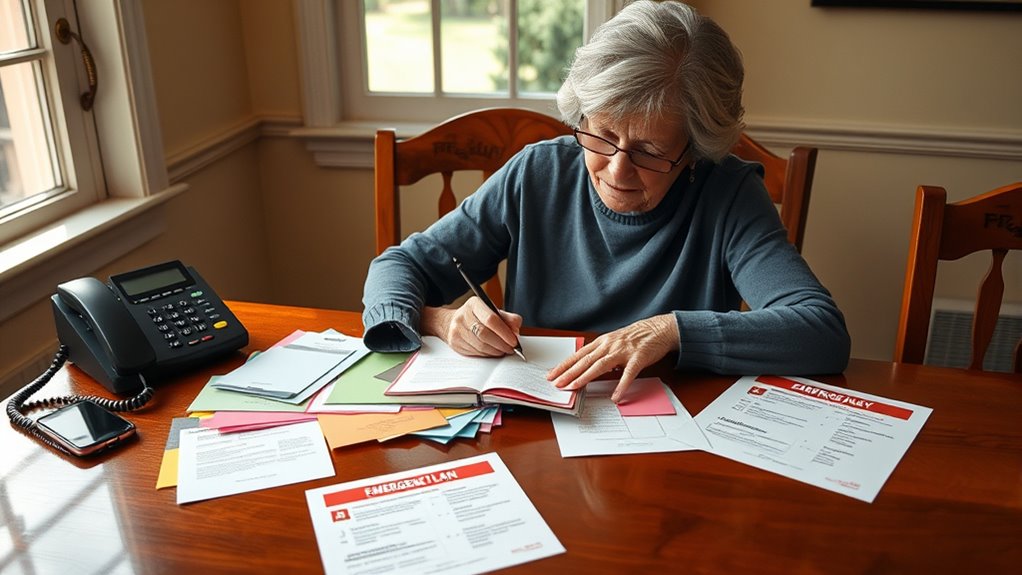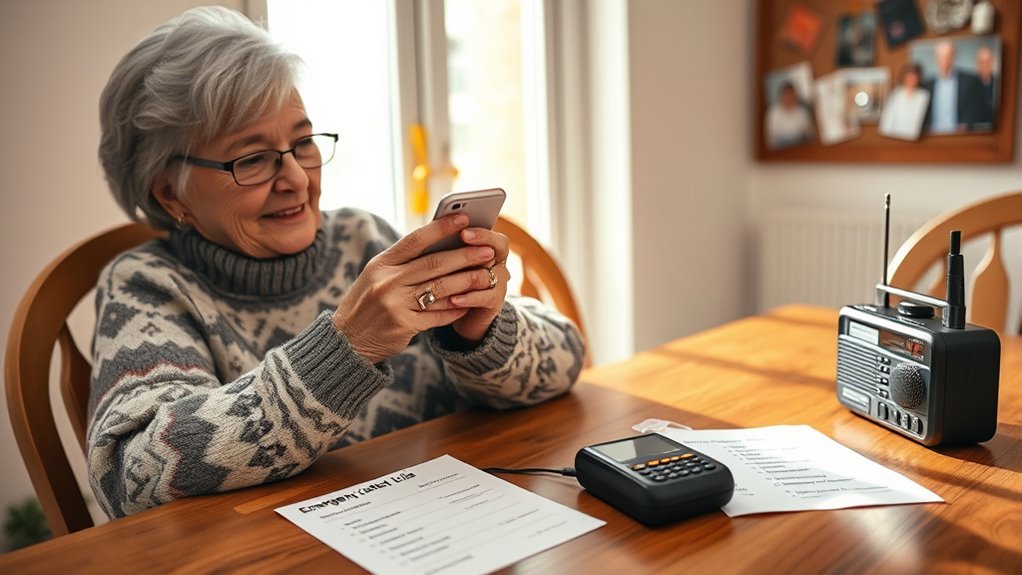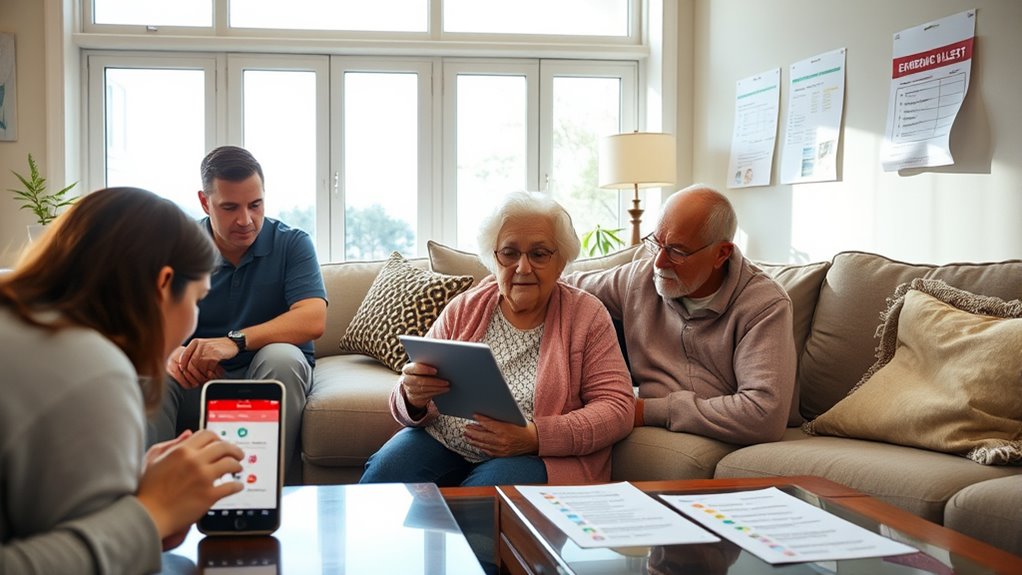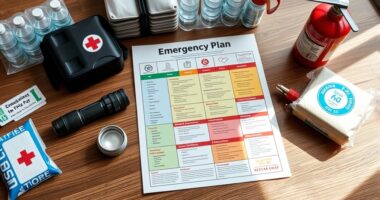To develop an effective emergency communication plan for seniors, start by evaluating their familiarity with technology, language, and hearing or cognitive challenges. Create a detailed, updated contact list including family, caregivers, and emergency services. Choose simple, accessible devices with alert features, and regularly test them. Establish a clear family and caregiver strategy, including personalized medical and accessibility needs. Conduct drills to ensure everyone is prepared. If you keep exploring, you’ll discover how to tailor these steps specifically for your loved ones’ safety.
Key Takeaways
- Maintain an updated, accessible emergency contact list tailored to seniors’ cultural and sensory needs.
- Choose simple, senior-friendly devices with emergency alert features and conduct regular functionality tests.
- Develop clear communication protocols involving family, caregivers, and emergency responders.
- Prepare personalized medical and accessibility information for quick reference during emergencies.
- Conduct routine drills to ensure preparedness, response efficiency, and effective use of communication tools.
Assessing Specific Communication Needs for Seniors

Understanding the specific communication needs of seniors is essential for developing effective emergency plans. You need to evaluate their familiarity with emergency communication technology, such as alarms, alerts, and mobile devices. Some seniors may struggle with new or complex technology, so choosing user-friendly tools is vital. Additionally, consider cultural communication barriers that might affect how they receive and interpret emergency messages. Language differences, hearing impairments, or cultural preferences might influence their understanding of alerts or instructions. Incorporating creativity in communication into tools, such as personalized messages or visual aids, can also enhance understanding for seniors with visual or cognitive challenges. For example, employing visual symbols or creative messaging techniques can make critical information more accessible. Moreover, assessing their digital literacy can help determine the most effective communication methods, ensuring they are comfortable with the chosen tools. Understanding communication barriers specific to their situation allows for more tailored messages that resonate. Incorporating inclusive communication strategies can further improve message comprehension across diverse senior populations. By assessing these factors, you guarantee your emergency communication plan is tailored to their needs, increasing the likelihood they will receive timely, clear information during a crisis. This proactive approach helps prevent misunderstandings and ensures everyone stays safe when it matters most.
Creating a Comprehensive Emergency Contact List

You need a complete emergency contact list that includes essential information like phone numbers and addresses for family, friends, and caregivers. Keep this list updated regularly to guarantee all details are current and reliable. Having a clear, organized list makes it easier to respond quickly in any emergency. Additionally, consider including emergency gear information such as medical supplies or emergency plans to ensure preparedness beyond just contact details. Regularly reviewing and practicing your emergency procedures can also greatly improve response times and effectiveness, especially when considering communication plans tailored for seniors to ensure clear and effective information sharing. Incorporating emergency response protocols into your planning can further enhance safety and preparedness, which is especially important given the diverse net worth of individuals involved in community support and resource allocation.
Essential Contact Information
Having a complete and up-to-date emergency contact list is essential for guaranteeing quick assistance during emergencies. Make sure it includes trusted family members, close friends, your primary healthcare provider, and local emergency services. Consider language barriers and cultural considerations when listing contacts—include contacts who speak your preferred language or understand your cultural needs. If you live in a multicultural community, add bilingual contacts or community organizations that can assist you effectively. Keep this list in a visible location, such as near your phone or in your emergency kit. Confirm your contacts are aware of their roles and how to reach you quickly. Regularly review and update this list to reflect any changes in contacts or circumstances. Additionally, understanding the Gold IRA markets can help diversify your investments and secure your financial future in unpredictable times. Recognizing the importance of emergency preparedness ensures that you are better equipped to respond effectively during crises. Remember that effective communication systems are vital for timely assistance and coordination during emergencies.
Regular List Updates
Regularly updating your emergency contact list guarantees it remains accurate and reliable when you need it most. Review and verify contact details regularly, especially if medication management or social engagement routines change. Keep emergency contacts current, including physicians, nearby family, and friends who know your needs. A well-maintained list can prevent confusion during crises. Use the table below to organize key contacts:
| Name | Relationship | Phone Number |
|---|---|---|
| Dr. Smith | Primary Care Physician | (123) 456-7890 |
| Jane Doe | Daughter | (987) 654-3210 |
| John Roe | Close Friend | (555) 123-4567 |
Updating your list ensures quick access to support, especially if medication adjustments or social activities require prompt coordination. Maintaining an accurate emergency contact list is essential for effective communication during emergencies. Incorporating data-driven strategies can help keep your contact information current and organized, reducing the risk of oversight. Additionally, using color-coded labels or digital apps can streamline updates and improve visibility of critical contacts. Regular reviews of your list can also help identify potential gaps in coverage, ensuring all necessary contacts are included. Staying mindful of your spiritual energy can foster a calm and focused mindset during stressful situations, aiding in clearer communication.
Selecting Appropriate Communication Devices and Tools

Choosing the right communication devices is vital for ensuring your safety during emergencies. Look for easy-to-use devices with emergency alert features that can quickly notify loved ones or responders. Also, make sure the tools you select are compatible with your existing technology and accessible to your needs. Incorporating specialized emergency communication systems can further enhance your safety and response capabilities. Ensuring these devices are safety compliant and regularly tested can prevent failures when you need them most.
Easy-to-Use Devices
Selecting the right communication devices for seniors involves prioritizing simplicity, accessibility, and reliability. Look for devices with straightforward features, like large buttons or clear screens, making them easy to operate. Smartphone features such as simplified interfaces or emergency contact buttons can be helpful. Voice-activated devices are especially useful, allowing you to make calls or send messages hands-free, reducing frustration. Consider these options:
| Device Type | Key Features |
|---|---|
| Simplified Smartphones | Large icons, easy navigation |
| Voice Activated Devices | Hands-free calling, voice commands |
| Senior-friendly Tablets | Large screens, simple menus |
| Emergency Phones | One-touch calling, loud volume |
Choose devices that match your comfort level, ensuring quick, stress-free communication during emergencies. Using appropriate communication devices can significantly enhance safety and peace of mind for seniors and their caregivers. Additionally, selecting devices with trusted brand reputation can provide added assurance of durability and support. Incorporating training and familiarization with these devices can further boost confidence and effective usage during urgent situations. Being aware of user-friendly features helps ensure the device will meet the user’s needs comfortably. As the wisdom of ancient civilizations suggests, selecting tools that align with the user’s abilities can lead to better outcomes and lasting safety.
Emergency Alert Features
Emergency alert features are essential tools that can quickly notify you and others during a crisis. They enhance safety by providing immediate alerts through your devices. When choosing devices, consider how their alert system integration works. Here are key points to keep in mind:
- Make sure the device can send alerts via multiple channels like sirens, vibrations, or visual signals.
- Check if it integrates with local emergency alert systems for real-time updates.
- Confirm the alert features are loud and clear enough for your hearing needs.
- Look for devices that allow customization of alert types and notifications.
Compatibility and Accessibility
Since compatibility and accessibility are indispensable for effective emergency communication, it’s important to guarantee that your devices work seamlessly with your existing technology and meet your specific needs. Choose tools that support visual communication, like large screens or flashing alerts, especially if hearing is a concern. Address language barriers by selecting devices with multilingual options or clear icons. Consider the following table for compatibility features:
| Feature | Description | Benefit |
|---|---|---|
| Visual Alerts | Bright flashing lights or visual signals | Assists those with hearing loss |
| Multilingual Support | Devices offering multiple language options | Overcomes language barriers |
| User-Friendly Interface | Simple, intuitive controls | Ensures easy operation |
Matching devices to your needs guarantees accessible, effective emergency communication.
Establishing a Family and Caregiver Communication Strategy

Creating a clear communication plan between family members and caregivers is essential for guaranteeing seniors receive timely assistance during emergencies. To establish effective family communication and caregiver coordination, follow these steps:
A clear communication plan ensures timely assistance for seniors during emergencies.
- Assign a primary contact person responsible for relaying information.
- Create a shared contact list with updated phone numbers and addresses.
- Set specific protocols for different emergency scenarios.
- Schedule regular check-ins to update plans and ensure everyone stays informed.
Planning for Special Medical and Accessibility Requirements

Planning for special medical and accessibility requirements guarantees that seniors receive the tailored support they need during emergencies. You should verify that medical alerts are easily accessible and clearly communicate any health conditions or medication needs. Keep a list of medications, dosages, and emergency contacts handy and updated regularly. If your senior uses mobility aids like walkers, wheelchairs, or canes, make sure these are in good condition and easily reachable. Inform emergency responders about their mobility aids and any specific requirements to facilitate quick assistance. Additionally, consider creating a personalized plan that outlines their medical needs and accessibility accommodations. This preparation ensures that first responders can provide appropriate support swiftly, reducing risks and ensuring safety during any emergency situation.
Conducting Regular Drills and Practice Runs

Regular drills and practice runs are essential to guarantee that seniors and their caregivers know exactly what to do in an emergency. These exercises help everyone become familiar with communication technology and community resources. To make your drills effective, consider these steps:
- Test your communication devices, like phones and alert systems, to ensure they work properly.
- Practice calling emergency services and notifying community resources.
- Simulate different scenarios to evaluate response times and clarity.
- Review and adjust your plan based on the drill’s results, making sure everyone stays informed and prepared.
Regular practice helps identify gaps, builds confidence, and ensures quick action when it matters most. Keep these drills routine, so your communication plan remains effective and reliable.
Maintaining and Updating the Communication Plan

To guarantee your emergency communication plan remains effective, you need to consistently maintain and update it as circumstances change. Regularly review your plan to reflect new contact information, technology integration updates, or changes in your living situation. Incorporate the latest tools, like emergency apps or alert systems, to enhance disaster preparedness. Keep a backup of digital contacts and store printed copies in accessible locations. As technology evolves, ensure your devices and communication methods stay current and functional. Revisit your plan after drills or real emergencies to identify gaps and improvements. Staying proactive with updates helps you respond swiftly and confidently during crises, reducing confusion and stress. An up-to-date plan ensures you’re always prepared, no matter how situations change.
Frequently Asked Questions
How Can Technology Be Adapted for Seniors With Cognitive Impairments?
When adapting technology for seniors with cognitive impairments, you should focus on simple, user-friendly assistive devices that support daily tasks. Incorporate cognitive training apps to help improve memory and problem-solving skills. Use clear visuals and straightforward instructions to minimize confusion. Regularly update and personalize the technology to match their evolving needs, ensuring they feel confident and supported while staying connected and safe.
What Legal Considerations Exist for Emergency Communication Plans Involving Seniors?
You might think legal considerations are complex, but focusing on legal compliance and privacy protections makes it manageable. When creating emergency communication plans for seniors, guarantee you’re following relevant laws like HIPAA or state privacy regulations. Protect their personal information and obtain necessary consents. By prioritizing transparency and adherence to legal standards, you safeguard seniors’ rights and foster trust, making emergency plans both effective and compliant.
How Do Language Barriers Affect Emergency Communication Strategies for Diverse Seniors?
You should recognize that language barriers critically impact emergency communication strategies for diverse seniors. By implementing multilingual outreach, you guarantee messages reach non-English speakers effectively. Cultural sensitivity is vital; it helps tailor communication to respect different backgrounds and improve understanding. When you adapt your approach, you foster trust and make sure seniors receive timely information, ultimately enhancing their safety during emergencies.
What Funding Options Are Available to Support Emergency Communication Preparedness?
Think of funding options as a toolkit for your success. You can explore grant opportunities designed for community resilience and emergency preparedness, which often provide essential resources. Building strong community partnerships also open up additional support, sharing costs and expertise. These combined efforts guarantee your plans are well-funded, robust, and inclusive, helping you safeguard everyone effectively during emergencies. Stay proactive by seeking diverse funding streams to strengthen your initiatives.
How Can Families Coordinate With Local Authorities During a Senior Emergency?
You can coordinate with local authorities by fostering community partnerships and participating in volunteer training programs. Reach out to emergency services to understand their protocols and share information about your senior loved ones. Volunteer training helps you effectively assist during emergencies. Maintain open communication channels, attend local meetings, and collaborate with community organizations to guarantee everyone is prepared and knows how to respond swiftly during a crisis.
Conclusion
By thoughtfully nurturing your emergency communication plan, you guarantee your loved ones feel more secure and connected, even during life’s quietest moments. Regularly tending to and gently refining your approach allows it to blossom into a steady, reassuring presence. Remember, with patience and care, your preparedness can become a comforting foundation—guiding everyone safely through life’s unpredictable rhythms, like a steady lighthouse amid gentle waves, offering hope and peace when they need it most.









